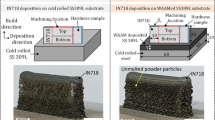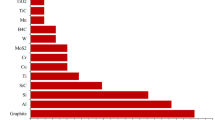Abstract
High-strength alloys have significant application values in aerospace industry due to their excellent mechanical properties. However, grinding of these alloys, which is generally used for precision machining, suffers from problems like high grinding temperature and poor surface quality. Having relatively lower grinding temperature and smaller grinding force, micro-grinding is a high-efficient manufacturing method for precision machining of difficult-to-cut materials. Nevertheless, the side effects induced by current composite grinding methods, such as temperature gradient and chatter marks, tend to be more obvious in the micro-machining process. Atmospheric pressure plasma jet (APPJ) can effectively improve metal surface wettability without changing surface structures. On the other hand, minimum quantity lubrication (MQL) can more efficiently cool and lubricate the grinding area. Here, we propose to induce APPJ and MQL cooling media into the micro-grinding area, and adjust the cooling and lubricating characteristics. Quenched GCr15 workpieces are machined under five different conditions (dry micro-grinding, nitrogen jet assisted micro-grinding, APPJ assisted micro-grinding, MQL assisted micro-grinding, and APPJ+MQL assisted micro-grinding), and grinding temperature, grinding force, surface roughness, and surface morphology of workpieces in each group are investigated and analyzed. The results indicate that APPJ can reduce grinding force and that APPJ+MQL micro-grinding can obtain surfaces with much better surface quality. Tensile experiments demonstrate that APPJ can reduce material elongation rate and promote material fracture, which contributes to its positive effect on the micro-grinding process. The environmentally-friendly method is expected to have promising application potentials in machining of difficult-to-cut materials.







Similar content being viewed by others
References
Wu G, Chan KC, Zhu LL, Sun LG, Lu J (2017) Dual-phase nanostructuring as a route to high-strength magnesium alloys. Nature 545:80–83. https://doi.org/10.1038/nature21691
Bowden D, Krysiak Y, Palatinus L, Tsivoulas D, Plana-Ruiz S, Sarakinou E, Kolb U, Stewart D, Preuss M (2018) A high-strength silicide phase in a stainless steel alloy designed for wear-resistant applications. Nat Commun 9:1374. https://doi.org/10.1038/s41467-018-03875-9
Neumeier S, Freund LP, Göken M (2015) Novel wrought γ/γ′ cobalt base superalloys with high strength and improved oxidation resistance. Scr Mater 109:104–107. https://doi.org/10.1016/j.scriptamat.2015.07.030
Pollock TM (2016) Alloy design for aircraft engines. Nat Mater 15:809–815. https://doi.org/10.1038/nmat4709
Cheng B, Kim YJ, Chou P (2016) Improving accident tolerance of nuclear fuel with coated Mo-alloy cladding. Nucl Eng Technol 48:16–25. https://doi.org/10.1016/j.net.2015.12.003
Jia DZ, Li CH, Zhang YB, Yang M, Wang YG, Guo SM, Cao HJ (2017) Specific energy and surface roughness of minimum quantity lubrication grinding Ni-based alloy with mixed vegetable oil-based nanofluids. Precis Eng 50:248–262. https://doi.org/10.1016/j.precisioneng.2017.05.012
Dai CW, Ding WF, Zhu YJ, Xu JH, Yu HW (2018) Grinding temperature and power consumption in high speed grinding of Inconel 718 nickel-based superalloy with a vitrified CBN wheel. Precis Eng 52:192–200. https://doi.org/10.1016/j.precisioneng.2017.12.005
Guo SM, Li CH, Zhang YB, Wang YG, Li BK, Yang M, Zhang XP, Liu GT (2017) Experimental evaluation of the lubrication performance of mixtures of castor oil with other vegetable oils in MQL grinding of nickel-based alloy. J Clean Prod 140:1060–1076. https://doi.org/10.1016/j.jclepro.2016.10.073
Zhang YB, Li CH, Jia DZ, Zhang DK, Zhang XW (2015) Experimental evaluation of MoS2 nanoparticles in jet MQL grinding with different types of vegetable oil as base oil. J Clean Prod 87:930–940. https://doi.org/10.1016/j.jclepro.2014.10.027
Mao C, Zhou X, Yin LR, Zhang MJ, Tang K, Zhang J (2016) Investigation of the flow field for a double-outlet nozzle during minimum quantity lubrication grinding. Int J Adv Manuf Technol 85:291–298. https://doi.org/10.1007/s00170-015-7896-2
Balan ASS, Vijayaraghavan L, Krishnamurthy R, Kuppan P, Oyyaravelu R (2016) An experimental assessment on the performance of different lubrication techniques in grinding of Inconel 751. J Adv Res 7:709–718. https://doi.org/10.1016/j.jare.2016.08.002
Nguyen T, Zarudi I, Zhang LC (2007) Grinding-hardening with liquid nitrogen: mechanisms and technology. Int J Mach Tool Manuf 47:97–106. https://doi.org/10.1016/j.ijmachtools.2006.02.010
Guo B, Zhao QL (2017) Ultrasonic vibration assisted grinding of hard and brittle linear micro-structured surfaces. Precis Eng 48:98–106. https://doi.org/10.1016/j.precisioneng.2016.11.009
Zhao QL, Sun ZY, Guo B (2016) Material removal mechanism in ultrasonic vibration assisted polishing of micro cylindrical surface on SiC. Int J Mach Tool Manuf 103:28–39. https://doi.org/10.1016/j.ijmachtools.2016.01.003
Chen JB, Fang QH, Wang CC, Du JK, Liu F (2016) Theoretical study on brittle-ductile transition behavior in elliptical ultrasonic assisted grinding of hard brittle materials. Precis Eng 46:104–117. https://doi.org/10.1016/j.precisioneng.2016.04.005
Cameron A, Bauer R, Warkentin A (2010) An investigation of the effects of wheel-cleaning parameters in creep-feed grinding. Int J Mach Tool Manuf 50:126–130. https://doi.org/. https://doi.org/10.1016/j.ijmachtools.2009.08.008
Hood R, Cooper P, Aspinwall DK, Soo SL, Lee DS (2015) Creep feed grinding of γ-tial using single layer electroplated diamond superabrasive wheels. CIRP J Manuf Sci Technol 11:36–44. https://doi.org/10.1016/j.cirpj.2015.07.001
Bhaduri D, Soo SL, Aspinwall DK, Novovic D, Bohr S, Harden P, Webster JA (2017) Ultrasonic assisted creep feed grinding of gamma titanium aluminide using conventional and superabrasive wheels. CIRP Ann-Manuf Technol 66:341–344. https://doi.org/10.1016/j.cirp.2017.04.085
Shih HR, Shu KM (2008) A study of electrical discharge grinding using a rotary disk electrode. Int J Adv Manuf Technol 38:59–67. https://doi.org/10.1007/s00170-007-1068-y
Yin QF, Wang XQ, Wang P, Qian ZQ, Lin Z, Zhang YB (2016) Fabrication of micro rod electrode by electrical discharge grinding using two block electrodes. J Mater Process Tech 234:143–149. https://doi.org/10.1016/j.jmatprotec.2016.03.023
Cheng J, Gong YD (2014) Experimental study of surface generation and force modeling in micro-grinding of single crystal silicon considering crystallographic effects. Int J Mach Tool Manuf 77:1–15. https://doi.org/10.1016/j.ijmachtools.2013.10.003
Kadivar M, Azarhoushang B, Shamray S, Krajnik P (2018) The effect of dressing parameters on micro-grinding of titanium alloy. Precis Eng 51:176–185. https://doi.org/10.1016/j.precisioneng.2017.08.008
Chavoshi SZ, Luo XC (2015) Hybrid micro-machining processes: a review. Precis Eng 41:1–23. https://doi.org/10.1016/j.precisioneng.2015.03.001
Lee PH, Lee SW (2011) Experimental characterization of micro-grinding process using compressed chilly air. Int J Mach Tool Manuf 51:201–209. https://doi.org/10.1016/j.ijmachtools.2010.11.010
Kubiak KJ, Wilson MCT, Mathia TG, Carval P (2011) Wettability versus roughness of engineering surfaces. Wear 271:523–528. https://doi.org/10.1016/j.wear.2010.03.029
Chen FZ, Liu JY, Cui Y, Huang S, Song JL, Sun J, Xu WJ, Liu X (2016) Stability of plasma treated superhydrophobic surfaces under different ambient conditions. J Colloid Interf Sci 470:221–228. https://doi.org/10.1016/j.jcis.2016.02.058
Liu X, Chen FZ, Huang S, Yang XL, Lu Y, Zhou WL, Xu WJ (2015) Characteristic and application study of cold atmospheric-pressure nitrogen plasma jet. IEEE Trans Plasma Sci 43:1959–1968. https://doi.org/10.1109/TPS.2015.2427852
Liu JY, Song JL, Wang GS, Chen FZ, Liu S, Yang XL, Sun J, Zheng HX, Huang L, Jin ZJ, Liu X (2018) Maskless hydrophilic patterning of the superhydrophobic aluminum surface by an atmospheric pressure microplasma jet for water adhesion controlling. ACS Appl Mater Interfaces 10:7497–7503. https://doi.org/10.1021/acsami.7b19431
Katahira K, Ohmori H, Takesue S, Komotori J, Yamazaki K (2015) Effect of atmospheric-pressure plasma jet on polycrystalline diamond micro-milling of silicon carbide. CIRP Ann-Manuf Technol 64:129–132. https://doi.org/10.1016/j.cirp.2015.04.097
Bastawros AF, Chandra A, Poosarla PA (2015) Atmospheric pressure plasma enabled polishing of single crystal sapphire. CIRP Ann-Manuf Technol 64:515–518. https://doi.org/10.1016/j.cirp.2015.04.037
Zhang YB, Li CH, Jia DZ, Li BK, Wang YG, Yang M, Hou YL, Zhang XW (2016) Experimental study on the effect of nanoparticle concentration on the lubricating property of nanofluids for MQL grinding of Ni-based alloy. J Mater Process Tech 232:100–115. https://doi.org/10.1016/j.jmatprotec.2016.01.031
Wang YG, Li CH, Zhang YB, Yang M, Li BK, Dong L, Wang J (2018) Processing characteristics of vegetable oil-based nanofluid MQL for grinding different workpiece materials. Int J Precis Eng Manuf-Green Tech 5:327–339. https://doi.org/10.1007/s40684-018-0035-4
Zhang XP, Li CH, Zhang YB, Wang YG, Li BK, Yang M, Guo SM, Liu GT, Zhang NQ (2017) Lubricating property of MQL grinding of Al2O3/SiC mixed nanofluid with different particle sizes and microtopography analysis by cross-correlation. Precis Eng 47:532–545. https://doi.org/10.1016/j.precisioneng.2016.09.016
Saberi A, Rahimi AR, Parsa H, Ashrafijou M, Rabiei F (2016) Improvement of surface grinding process performance of CK45 soft steel by minimum quantity lubrication (MQL) technique using compressed cold air jet from vortex tube. J Clean Prod 131:728–738. https://doi.org/10.1016/j.jclepro.2016.04.104
Rabiei F, Rahimi AR, Hadad MJ, Ashrafijou M (2015) Performance improvement of minimum quantity lubrication (MQL) technique in surface grinding by modeling and optimization. J Clean Prod 86:447–460. https://doi.org/10.1016/j.jclepro.2014.08.045
Wang YG, Li CH, Zhang YB, Yang M, Li BK, Jia DZ, Hou YL, Mao C (2016) Experimental evaluation of the lubrication properties of the wheel/workpiece interface in minimum quantity lubrication (MQL) grinding using different types of vegetable oils. J Clean Prod 127:487–499. https://doi.org/10.1016/j.jclepro.2016.03.121
Lee PH, Lee SW, Lim SH, Lee SH, Ko HS, Shin SW (2015) A study on thermal characteristics of micro-scale grinding process using nanofluid minimum quantity lubrication (MQL). Int J Precis Eng Manuf 16:1899–1909. https://doi.org/10.1007/s12541-015-0247-2
Chaudhari A, Soh ZY, Wang H, Kumar AS (2018) Rehbinder effect in ultraprecision machining of ductile materials. Int J Mach Tool Manuf 133:47–60. https://doi.org/10.1016/j.ijmachtools.2018.05.009
Funding
This work was financially supported by the National Basic Research Program of China (Grant No. 2015CB057304), National Natural Science Foundation of China (NSFC, Grant No. 51305060), and the Fundamental Research Funds for the Central Universities (DUT18JC19).
Author information
Authors and Affiliations
Corresponding author
Additional information
Publisher’s note
Springer Nature remains neutral with regard to jurisdictional claims in published maps and institutional affiliations.
Rights and permissions
About this article
Cite this article
Liu, J., Chen, Y., Zhang, J. et al. Atmospheric pressure plasma jet and minimum quantity lubrication assisted micro-grinding of quenched GCr15. Int J Adv Manuf Technol 106, 191–199 (2020). https://doi.org/10.1007/s00170-019-04469-5
Received:
Accepted:
Published:
Issue Date:
DOI: https://doi.org/10.1007/s00170-019-04469-5




